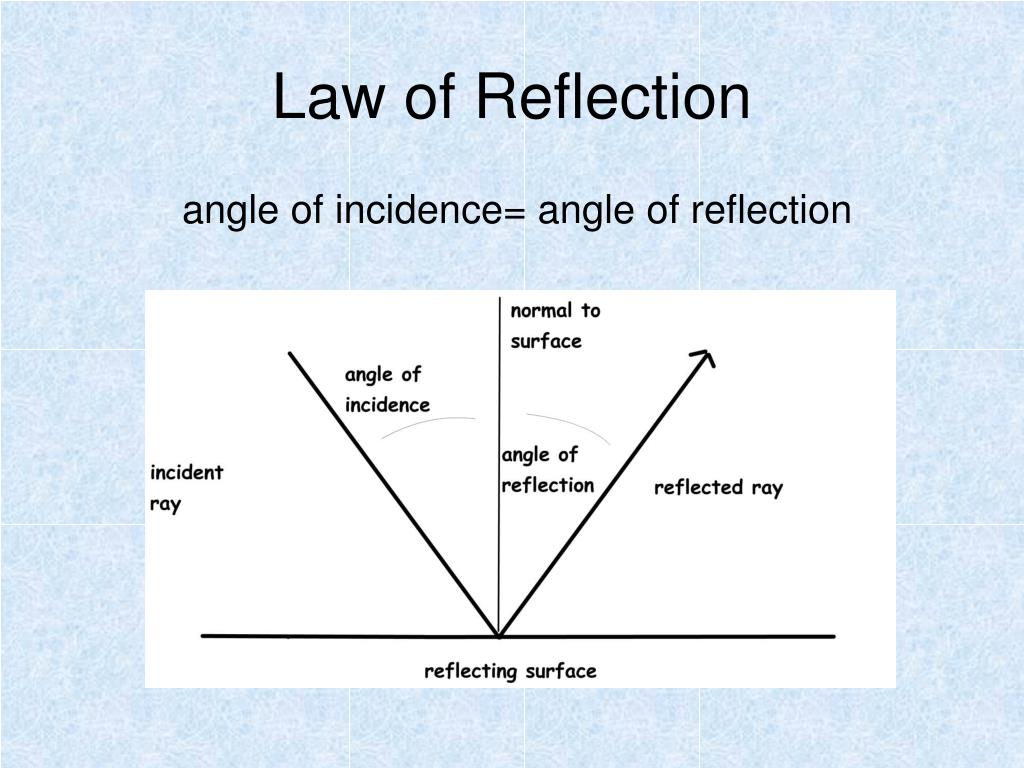

Scientists, mathematicians, and engineers working with other forms of radiation, such as sound or microwaves, can apply the law of reflection when working with acoustics or X-rays. What will be the angle of reflection? Today, the law of reflection is considered a basic principle in the branch of physics known as optics, which deals with the behavior of light. Q1: A beam of light falls at an angle of 30° with the mirror surface on a flat mirror. However, the only example (related to visible light) that we encounter almost every day concerns the mirrors we have in our homes. There are countless examples where the law of reflection comes into play, mainly because the law of reflection works not only for visible light, but also for other electromagnetic radiation. In this session, let`s learn more about the laws of reflection (first set of thinking and second reflection theorem), types of reflection, examples, differences, and total inner thinking. Choose the right option: how big is the object relative to the wavelength of the wave that propagates when reflection occurs? We know that light is the form of energy that can be subjected to various phenomena such as refraction, reflection, diffraction and interference. Hero (also known as Heron) was a notable mathematician and mechanical engineer whose many inventions include an early vending machine (perhaps the first) that dispensed holy water when a coin was deposited. The law of reflection has been described at least since the hero of Alexandria in the first century AD. Here is a diagram to help you visualize the law of reflection a little better: The principle that when light rays fall on the smooth surface, the angle of reflection is equal to the angle of incidence, the incident beam, the reflected beam and the perpendicular to the surface are all in the same plane. Because of this predictability, we can determine the path it will take once it hits a flat surface. Light is known to "behave" in a very predictable way, which is actually a very good thing for us. By reflecting light, concave mirrors emit real and inverted images when the object is blurred, and a virtual, vertical, and magnified image when the object is less than the focal length of the mirror pole.

(Both angles are labeled with the Greek letter "theta," accompanied by an index character read "theta-i" for the angle of incidence and "theta-r" for the angle of reflection.) The law of reflection states that when a beam of light is reflected on a surface, the angle of incidence is equal to the angle of reflection. The angle between the reflected beam and the normal is called the reflection angle. The angle between the incident beam and the normal is called the angle of incidence. The normal line divides the angle between the incident beam and the reflected beam into two equal angles. This line is called the normal line (denoted N in the diagram).

At the point of incidence where the beam hits the mirror, a line can be drawn perpendicular to the surface of the mirror. The beam of light that leaves the mirror is called the reflected beam (denoted R in the diagram).

In the diagram, the beam of light approaching the mirror is called the incident beam (denoted I in the diagram). The reflection angle 0r of a beam is the angle measured from the reflected beam relative to the normal surface. It also indicates that the angle that the incident beam makes with the normal is equal to the angle that the reflected beam makes with the normal. Do you notice how the reflection of the woman looks into the camera, but not the lady herself? (Photo credit: freestockphotos) The law of reflection (in physics) states that when a beam of light hits a flat surface, the incident beam, the reflected beam and the "normal" beam on the mirror surface are all in the same plane. The law of reflection states that the angle of incidence is equal to the angle of reflection when light (or other similar forms of energy) hits a smooth surface. Choose the right answer: what is the case with reflection if the second medium is a perfect dielectric? The second law of reflection states that "the incident beam, the perpendicular to the surface at the point of incidence, and the reflected beam are all in the same plane." Let`s summarize all this again in scientific language. We first complete the given diagram with the angles of incidence and reflection shown above and also label the incident and reflected rays.


 0 kommentar(er)
0 kommentar(er)
